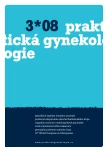Selektivní antagonista muskarinových M3 receptorů v léčbě hyperaktivního močového měchýře (overactive bladder, OAB) – darifenacin
Authors:
Jiří Slíva; J. Minárik
Authors‘ workplace:
Ústavy farmakologie 2. a 3. LF UK Praha
1; New EU Magazine of Medicine
2
Published in:
Prakt Gyn 2008; 12(3): 146-149
Overview
Muscarinic receptors play an important role in the current therape utic appro aches in overactive bladder. Darifenacin is a new substance, selectively inhibiting muscarinic M3 subtypes of these receptors. This property may be responsible for its go od tolerability and go od safety profile in general. Its efficacy, as well as its influence on the qu ality of life of pati ents was evalu ated in many clinical tri als.
Key words:
darifenacin – overactive bladder (OAB) – muscarinic receptors
Sources
1. Goepel M, Hoffmann JA, Piro M et al. Prevalence and physici an awareness of symptoms of urinary bladder dysfuncti on. Eur Urol 2002; 41(3): 234 – 239.
2. Milsom I, Abrams P, Cardozo L et al. How widespre ad are the symptoms of an overactive bladder and how are they managed? A populati on‑based prevalence study. BJU Int 2001; 87(9): 760 – 766.
3. Haab F, Stewart L, Dwyer P. Darifenacin, an M3 selective receptor antagonist, is an effective and well‑tolerated once - daily tre atment for overactive bladder. Eur Urol 2004; 45(4): 420 – 429.
4. Skerjanec A. The clinical pharmacokinetics of darifenacin. Clin Pharmacokinet 2006; 45(4): 325 – 350.
5. Steers W, Corcos J, Fo ote J, Kralidis G. An investigati on of dose titrati on with darifenacin, an M3 - selective receptor antagonist. BJU Int 2005; 95(4): 580 – 586.
6. Kerbusch T, Wahlby U, Milligan PA, Karlsson MO. Populati on pharmacokinetic modelling of darifenacin and its hydroxylated metabolite using po oled data, incorporating saturable first - pass metabolism, CYP2D6 genotype and formulati on - dependent bi o availability. Br J Clin Pharmacol 2003; 56(6): 639 – 652.
7. Cardozo L, Dixon A. Incre ased warning time with darifenacin: a new concept in the management of urinary urgency. J Urol 2005; 173(4): 1214 – 1218.
8. Chapple C, Steers W, Norton P et al. A po oled analysis of three phase III studi es to investigate the efficacy, tolerability and safety of darifenacin, a muscarinic M3 selective receptor antagonist, in the tre atment of overactive bladder. BJU Int 2005; 95(7): 993 – 1001.
9. Chapple CR, Khullar V, Gabri el Z et al. The Effects of Antimuscarinic Tre atments in Overactive Bladder: An Update of a Systematic Revi ew and Meta‑Analysis. Eur Urol 2008.
10. Abrams P, Kelleher C, Huels J et al. Clinical relevance of he alth - related qu ality of life o utcomes with darifenacin. BJU Int 2008; 102(2): 208 – 213.
11. Ancelin ML, Artero S, Portet F et al. Non - degenerative mild cognitive impairment in elderly people and use of anticholinergic drugs: longitudinal cohort study. BMJ 2006; 332(7539): 455 – 459.
12. Haab F, Corcos J, Si ami P et al. Long‑term tre atment with darifenacin for overactive bladder: results of a 2 - ye ar, open - label extensi on study. BJU Int 2006; 98(5): 1025 – 1032.
13. Kay GG, Wesnes KA. Pharmacodynamic effects of darifenacin, a muscarinic M selective receptor antagonist for the tre atment of overactive bladder, in he althy volunteers. BJU Int 2005; 96(7): 1055 – 1062.
14. Lipton RB, Kolodner K, Wesnes K. Assessment of cognitive functi on of the elderly populati on: effects of darifenacin. J Urol 2005; 173(2): 493 – 498.
15. Zinner N, Susset J, Gittelman M et al. Efficacy, tolerability and safety of darifenacin, an M(3) selective receptor antagonist: an investigati on of warning time in pati ents with OAB. Int J Clin Pract 2006; 60(1): 119 – 126.
Labels
Paediatric gynaecology Gynaecology and obstetrics Reproduction medicineArticle was published in
Practical Gynecology

2008 Issue 3
Most read in this issue
- Chronic vaginal dryness in oncology patients
- Particular characteristics of anorexia nervosa in adolescent girls
- Selektivní antagonista muskarinových M3 receptorů v léčbě hyperaktivního močového měchýře (overactive bladder, OAB) – darifenacin
- Prenatal preventi on of dental caries
